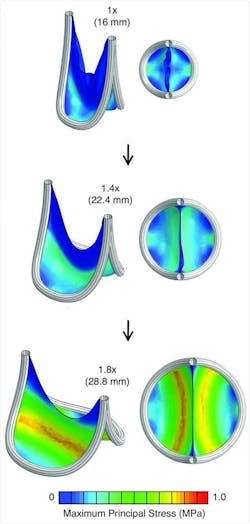Artificial Heart Valve for Children Can be Expanded to Grow Along with the Patient
Biomedical engineers at Boston Children’s Hospital have developed the first-ever artificial heart valve for children that can be enlarged as the patient grows older and gets bigger.
Congenital heart valve disease is life-threatening. Children with this condition may need multiple valve replacement surgeries early in their lives, as the valve cannot grow as the child’s heart grows. However, these surgeries are risky and pose a threat to the child’s health.
The new valve, which could eliminate the replacement surgeries, consists of polymeric leaflets attached to a stainless-steel stent. To enlarge the valve, a doctor uses keyhole surgery to insert a rubber tube attached to a deflated balloon in the valve. They inflate the balloon and, as it expands, the valve also spreads apart to match the child’s heart size.
The new valve, a biomimetic prosthetic valve, adapts to accommodate growth and structural asymmetries within the heart. In previous heart valve models, three leaflet-like flaps provide a one-way inlet or outlet for blood flow. However, the new heart valve only has two flaps and a geometry designed to maintain closure along with one-way flow even when the veins expand in diameter.
"Veins carry approximately 70% of our blood volume,” says Dr. Sophie C. Hofferberth, a surgical resident and researcher at Boston Children's Hospital. “The vein’s dimensions can change dramatically depending on body position, yet the valves must remain functional. We mimicked the geometric profile of the human venous valve to design a bi-leaflet valve that can grow without losing one-way flow control.”
The new heart valve has been tested in large animal models, computer simulations and benchtop studies, demonstrating that it works across a broad range of sizes and retains functionality and efficacy when it is expanded.
Though the study requires human testing and longer-follow up times, there is more work needed to validate the design. If it passes through rigorous testing, it could help more than 1.35 million children across the globe who were born with a congenital heart valve disorder.
The researchers also found that the new prosthetic valve promotes favorable blood flow through the valve and reduce the risk of blood clots, which are often seen in existing valve replacements.
A Little Background: What is congenital heart valve disease?
Congenital heart valve diseases appear if one or more of heart valves do not work well, leading to problems such as regurgitation, stenosis and atresia. Usually, this happen when a heart’s valves do not develop before birth, causing a defect that keeps the valve from closing completely.
Regurgitations happen when blood backflows because the valve does not close tightly or adequately. The most common cause of blood backflow is a valve prolapse.
Stenosis happens when the flaps become thick, stiff or fuse, resulting in the inability of the valve to open fully. Stenosis leads to blockage of blood flow. Atresia pertains to a condition in which the valve does not have an opening for the blood to pass through.
All these conditions lead to a wide range of heart problems and can endanger the life of the child. Over time, these problems strain the heart because it works double-time to compensate for the valve defect. It can cause serious problems such as aortic aneurysm, dilated cardiomyopathy and heart failure.


